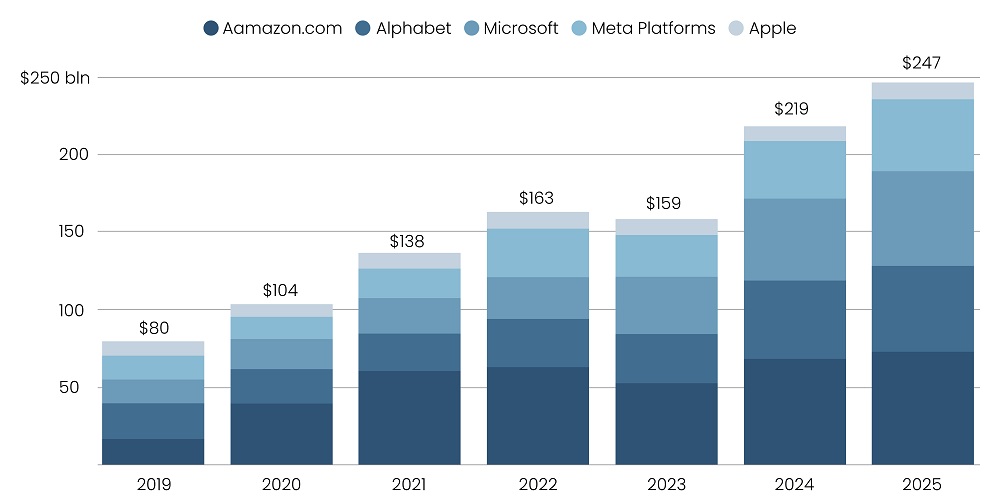As AI reshapes industries and accelerates innovation, it brings new energy challenges. To meet AI’s immense processing demands, tech companies are leveraging nuclear power, renewable energy, and AI-driven strategies while prioritizing sustainability goals.
The energy consumption required to support AI systems is rapidly increasing, with data centers projected to consume up to 9% of US electricity by 2030, more than double the current amount, per EPRI. AI computing power is doubling roughly every 100 days, according to research published by Science Partner Journal in January 2023. Unlike traditional software, AI programs continuously process vast datasets, often using 33 times more energy to perform similar tasks. The growing demand has even led to the extended use of fossil fuel plants, delaying their planned retirements to meet the electricity needs of AI-driven systems. By the end of the decade, around 54 GW of US coal power, representing 4% of the country’s electricity, is expected to retire, a 40% decrease from last year’s forecast, per S&P Global Commodity Insights. With AI programs running 24/7, tech companies are grappling with both rising electricity costs and the challenge of reducing greenhouse emissions.
Tech Giants Transitions to Clean Energy
In 2024, tech giants Google and Microsoft acknowledged that the increasing energy demands of AI are making it difficult to meet their pre-established climate targets. In 2020, Google committed to running all global operations on 24/7 carbon-free energy by 2030, ensuring continuous use of clean energy across all locations and power grids.
Since 2020, there has been an increase of 30% in carbon emissions due to the expansion of data centers, as per Microsoft's Sustainability Report. Microsoft signed a 20-year power purchase agreement (PPA) with Constellation Energy in September 2024 to provide clean energy to power these data centers. This agreement involves restarting a unit of a decommissioned Three Mile Island nuclear plant in Pennsylvania. The plant will generate 835 megawatts of carbon-free electricity, helping to power Microsoft’s data centers as part of its broader goal of becoming carbon-negative by 2030.
Read more: Unlocking M&A Potential: The Impact of Fed’s Rate Strategy
Navigating the Financial and Environment Trade-offs
Figure: Big Tech’s Soaring Capital Expenditure Bill

Note: 2024 and 2025 are analysts’ consensus estimates
Source: Visible Alpha|G.Hay|Breakingviews|Sept. 30, 2024
The combined capex from Amazon, Alphabet, Microsoft, Meta platforms, and Apple is projected to increase from $80 billion in 2019 to $247 billion by 2025, per combined research by Visible Alpha, G.Hay, and Breakingviews. Tech giants are increasingly turning to PPA to meet the soaring energy demands of AI as high capex squeezes the operating margins. This helps them avoid the added financial burden of building their own solar or wind plants, which carries significant risks. In May 2024, Microsoft and Brookfield signed a PPA to develop 10.5 GW of renewables at an estimated cost of $10 billion. Although not cheap, PPAs, typically lasting around 15 years, provide predictable pricing and shield companies from energy market volatility. However, there is a risk of overspending on unused energy if demand for AI services doesn’t grow as anticipated, leaving firms with surplus power and potentially leading to losses if energy prices fall below the PPA rates. The potential revenue boosts from AI advancements could offset these challenges, justifying the high upfront investments in energy and infrastructure.
Read more: Dividend Recapitalization Pick up in 2024
The Role of Nuclear and Fusion Energy
As tech companies ramp up their AI operations, they face significant challenges in meeting the energy demands of data centers around the clock. PPAs have emerged as an essential strategy due to the inconsistent supply of renewable sources such as solar and wind energy. Nuclear, with its ability to provide what Microsoft refers to as “firm electricity,” is emerging as a key solution, filling the gaps of less reliable clean sources. Microsoft’s nuclear power investment will likely be the only viable clean energy option to foster AI growth until infrastructure expands. Despite being a clean energy source that helps tech companies achieve their climate goal, the environmental dangers linked with radioactive waste in nuclear energy present significant problems.
Fusion startups raised over $7.1 billion by July 2024, with most investments concentrated in a few key companies, per the Fusion Industry Association 2024 Report. These start-ups aim to develop nuclear fusion, a cleaner and more powerful energy source than traditional fission, offering carbon-free energy without long-lived radioactive waste. If fusion becomes commercially viable, it is expected to revolutionize trillion-dollar energy markets. Although still experimental and expensive, nuclear fusion shows great potential for meeting AI’s growing energy demands.

Optimizing Renewables with AI
Renewable energy sources face challenges like inconsistent production and grid instability as AI’s energy demands surge. However, AI can provide synergy and address these issues by optimizing renewable energy use. Researchers at the National Renewable Energy Laboratory in the US have reported that using invertible neutral networks has accelerated the wind turbine design process 100 times compared to conventional methods. AI algorithms analyze weather patterns and energy trends, allowing precise solar and wind availability forecasting, improving grid stability, and reducing waste. Google’s project with DeepMind implemented machine learning to optimize energy efficiency in its data centers, leading to a 40% reduction in the electricity used for cooling. Moreover, AI-powered smart grids can manage energy storage, ensuring excess power is saved and redistributed efficiently. AI’s efficiency gains could help mitigate its energy demands, making it a key player in the future of sustainable power management.
Read more: US Merger and Acquisition (M&A) 2H24 Outlook
Conclusion
Meeting AI’s immense energy needs requires a multifaceted approach. While tech companies are investing in nuclear power and exploring experimental fusion, AI’s potential to optimize renewable energy usage could be a key to achieving long-term sustainability. AI-powered systems can learn from bioinspired methods, providing intelligent control for large-scale energy integration, which remains underdeveloped. As the energy landscape evolves, AI will help mitigate the strain on energy infrastructure, emerging as a key player in energy consumption and an indispensable resource for boosting global efficiency.
Partner of choice for lower middle market-focused investment banks and private equity firms, SG Analytics provides offshore analysts with support across the deal life cycle. Our complimentary access to a full back-office research ecosystem (database access, graphics team, sector & and domain experts, and technology-driven automation of tactical processes) positions our clients to win more deal mandates and execute these deals in the most efficient manner.
About SG Analytics
SG Analytics (SGA) is an industry-leading global data solutions firm providing data-centric research and contextual analytics services to its clients, including Fortune 500 companies, across BFSI, Technology, Media & Entertainment, and Healthcare sectors. Established in 2007, SG Analytics is a Great Place to Work® (GPTW) certified company with a team of over 1200 employees and a presence across the U.S.A., the UK, Switzerland, Poland, and India.
Apart from being recognized by reputed firms such as Gartner, Everest Group, and ISG, SGA has been featured in the elite Deloitte Technology Fast 50 India 2023 and APAC 2024 High Growth Companies by the Financial Times & Statista.









